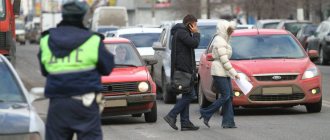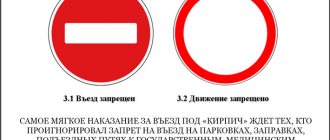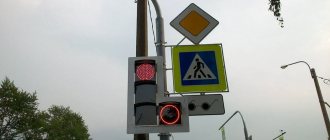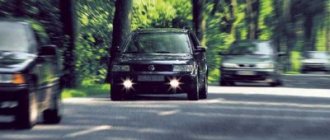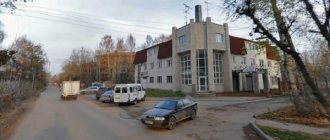Turning left on multi-lane roads seems at first glance to be a rather complicated maneuver.
This is due to the fact that you have to turn carefully and in a couple of steps.
But if you follow the rules, then no difficulties arise.
Rules for crossing signalized intersections
When approaching the intersection of two or more roads, we determine the type of intersection: regulated or unregulated. The order of our subsequent actions on the road depends on this. A regulated intersection is one where there is a traffic light or where a traffic police officer works as a traffic controller. For such intersections, the traffic rules have rules for their passage:
- The working three-color traffic light cancels the existing "Main Road" and "Give Way" signs.
- You can only move when there is a green (permissive) signal. Observe the lane when driving, and occupy the appropriate lane in advance.
- When the traffic light turns on, you must give way to all vehicles and pedestrians completing their maneuver at the intersection.
- At a traffic light with an additional section with an arrow, movement is allowed only in the direction indicated by the arrow and when it is turned on.
- The green arrow turns on simultaneously with the red signal. This means that travel in this direction is allowed, but you will need to give way to all vehicles moving in other directions.
- The actions of the traffic controller have the highest priority, even if they contradict road markings and traffic lights.
At first, novice drivers are afraid of busy intersections and turning left there. There are several reasons for this.
Firstly, during such a maneuver you have to be especially careful and let not only oncoming traffic pass, but also pedestrians. The speed of oncoming traffic can be high, which creates nervousness for beginners while waiting for a “window” to maneuver.
Secondly , when turning left, the car's stance impairs visibility and you have to additionally turn your head to safely complete the maneuver.
Thirdly, you often have to complete the maneuver while the green light is flashing and drive through the intersection together with cross-direction vehicles that have already started moving. This situation is eliminated if the traffic light has an additional side section with an arrow.
Recommendations for beginners that will help them feel more confident at an intersection:
- If you approach a traffic light that is green, reduce your speed. Perhaps at this time a car that did not have time to pass is completing the maneuver. You need to be especially careful at intersections with limited visibility.
- If you notice a red traffic light in the distance, take your time and reduce your speed. As you approach, the light may turn green and you will pass without stopping.
- It is not recommended to jump through a signalized intersection when the green signal is flashing. The traffic light blinks for only 3 seconds, and then it turns yellow, which is prohibited. You can continue driving only if you have to use emergency braking to stop.
Turn left at an intersection
When moving along the main road or at a traffic light and turning left, the driver must make sure that the action being performed is safe in accordance with the traffic rules. To do this, look in the rearview mirrors and at the zebra crossing for pedestrians ahead.
There can always be reckless drivers who will cut the corner or go around you on the left, for example, from tram tracks.
In the absence of oncoming traffic, you can make a left turn immediately, without taking a wait-and-see position in the center of the intersection. This method has its advantages. Minimum time spent in oncoming traffic without causing interference to cars behind.
In other cases, the driver must take a wait-and-see position on the line before entering the intersection, turn left and let oncoming vehicles pass. It is not recommended to drive into the middle of a road intersection for the following reasons:
- A waste of your time.
- If the light turns red and you don’t have time to pass, you may find yourself in an unpleasant situation and block the passage for cars.
- A car following may try to drive straight ahead without waiting for the lane to become completely clear, and cause an accident.
- Driving to the middle of the intersection is justified if the oncoming car is also turning left, then the maneuver can be completed without risk to other road users.
An additional turn signal arrow makes this maneuver easier.
When approaching such a traffic light, the driver must know the following:
- The signal from the main section of the traffic light always has priority. If the green arrow coincides with the same one at the traffic light, we drive through without hesitation - we have the main road.
- A green arrow with a red main light indicates the need to give priority to other vehicles. For example, cars turning right.
- We occupy our turning lane in advance. It has a graphic designation on the asphalt and a corresponding sign in front of the intersection. Changing lanes directly before the stop line is prohibited.
- When performing this maneuver, you cannot use the right hand rule. It is more correct to be guided only by traffic lights and additional signs.
The driver's actions in front of a traffic controller are no different. Turning left is allowed in only three cases:
- The traffic controller stands sideways, arms extended or down;
- The traffic controller stands on his left side, with his right arm extended to the side;
- The traffic controller stands facing you, with his right hand directed towards you.
Possible emergency situations and how to avoid them
Closely monitor pedestrians and their movements.
When completing a maneuver, the driver must always let them pass, even if there are no pedestrian crossing markings.
When moving behind a car turning left, be especially careful - it blocks your view, and a person may suddenly appear behind it.
A turn signal on in an oncoming or passing vehicle does not always mean that you are ready to make a maneuver. Perhaps the driver forgot to turn it off or there was a malfunction. We turn after the exact direction of movement of this car has become known.
Heavy vehicles and long vehicles have a larger turning radius and there is a possibility of the rear protruding part skidding. This must be taken into account when maneuvering with them in the same or opposite direction.
When turning left, always use the principle - do not start the maneuver if visibility is insufficient or the road section is occupied by other cars.
Finish the maneuver at a red light. To complete or not to complete? Analysis of ambiguous situations at intersections. Traffic rules completing a maneuver at an intersection
Children are taught what traffic lights mean at school. In the Traffic Rules, traffic light signals are, of course, discussed in more detail, but the essence does not change.
And yet, traffic light regulations are constantly violated. Despite the fact that these violations (driving through an intersection on a red traffic light) are quite serious, they are also the most common. In this case, the driver is punishable by a fine of up to 700 rubles, in accordance with Article 12.12 of the Administrative Code.
Remember two basic rules that must be followed when entering an intersection regulated by traffic lights: 1. Entering an intersection when the traffic light is red is strictly prohibited. 2. When leaving an intersection, you must clearly remember the traffic light signal that is on at the exact moment you are leaving.
The second point is very important when a controversial situation arises. It doesn’t matter what traffic light is on when you finish the maneuver - the main thing is what it was when you just started entering the intersection.
Even if you see that when you start driving through an intersection on a flashing green or yellow light, you will not be able to complete the maneuver before the red light turns on, there is nothing to worry about - you are not violating anything. The main thing is to start the maneuver on the enabling signal.
Often in such a situation, the traffic police inspector considers it necessary to stop the driver and point him to the red traffic light. However, remember: there was no violation in this case. Behave calmly and confidently. Explain the situation to the inspector. Such cases are usually designed for insecure beginners who begin to get scared and hesitate - a fine will be issued, rest assured, even if there was no actual violation.
If you are sure that you did everything correctly, but the inspector insists on a violation, let him draw up a report. In the protocol, indicate your vision of the situation, describe that you entered the intersection at the traffic light. Remember that it is the inspector who needs to prove your guilt, and not your innocence. As a rule, such protocols are not even put into use, because in practice it is quite difficult to prove such a gross violation as driving through an intersection at a prohibitory traffic light. In this case, insufficient evidence obliges the court to make a decision in favor of the driver (presumption of innocence).
However, if you really violated, there is no need to start arguing. This is, at a minimum, unethical. In addition, you cannot be 100% sure that this violation was not recorded by technical means (video or photo camera). If you argue, you will receive a maximum fine; if you immediately admit your guilt, you can get away with minimal sanctions.
In conclusion, a few words about the very place where you stop at a prohibitory traffic light. If you see a “Stop line” sign or corresponding road markings, then you are obliged to stop your car as prescribed by the Rules: without crossing the stop line markings or driving beyond the sign.
A lot of disputes occur when analyzing road accidents or simply situations in which the concept of “completed maneuver” is not precisely defined. I, also fascinated by this term, raised this topic. There were many disputes, but as usual, the truth was born here: It doesn’t matter
Whether a person completed the maneuver or not, if you took all the steps to avoid an accident, but it didn’t work out, then there is a way to prove that you are not to blame for the accident.
As usual, the “devil” is in the details. It is important to remember paragraph 1.2 of the traffic rules: “Give way ( do not interfere
)" - a requirement meaning that a road user must not start, resume or continue moving, or perform any maneuver if this may force other road users who have priority over him to change direction or speed.
It is not indicated anywhere during
the maneuver.
The maneuver of another participant in the movement led to the fact that you had to change the speed or direction of movement. Once again, the maneuver itself
.
Examples of situations: 1. Starting to move, change lanes, turn (turn) and stop Clause 8.1 of the traffic rules states: Before starting to move, change lanes, turn (turn) and stop, the driver is required to give signals with light direction indicators in the appropriate direction, and if they are missing or faulty - with his hand. When performing the maneuver, there should not be a danger to traffic, as well as interference (clause 1.2) to other road users. The signal for a left turn (turn) corresponds to the left arm extended to the sides or the right arm extended to the side and bent at the elbow at a right angle upward. The signal for a right turn corresponds to the right arm extended to the side or the left arm extended to the side and bent at the elbow at a right angle upward .The brake signal is given by raising the left or right hand
Should not be created
, that is, if a danger to movement or interference was created during the maneuver.
It doesn’t matter that the maneuver was already completed
, but
the situation was created
, which means the maneuver was carried out in violation.
And if before the start of the maneuver you had an advantage
over another participant in the movement, and as a result of this maneuver an accident was committed,
you tried to avoid the accident
, but it did not work, then you can prove that you were not the culprit of the accident.
It is important to prove that you had an advantage, you did not violate anything, you tried to avoid it (braked), and the accident occurred as a result of a maneuver.
For this, it is best to record from a video recorder, which additionally records the speed. It is also important to correctly attach the recording to the case: 1. Write in the protocol that there is a recording from the DVR and you will provide it during the analysis. The recording itself can be shown to traffic police officers, but not given. You should definitely keep a copy.2. Burn to disk. Bring it to the hearing along with a petition to include her in the case.
It seemed like that was all you could do. Then everything will depend on the inspector himself during the analysis; if he does not agree, then you need to challenge it. But again, it is important that you do not violate anything
.The maximum that they can drag in is 10.1, but that still needs to be proven.
If you act this way, then at least you have a mutual violation, and possibly proof of your complete innocence.
Unfortunately, the established opinion will play against you that if you are behind, then it is your fault, but nothing is impossible.
When turning left or turning outside an intersection, the same is true: Paragraph 8.8 of the traffic rules states: When turning left or turning outside an intersection, the driver of a trackless vehicle must give way to oncoming vehicles and a tram in the same direction. If, when turning outside an intersection, the width of the roadway is not sufficient to perform the maneuver from the extreme left position, it can be done from the right edge of the roadway (from the right shoulder). In this case, the driver must give way to passing and oncoming vehicles. Everything is more clear here. Nowhere is it said during
turn or turn.
8 . maneuvering
The turn signal or hand signal must be given well in advance of the maneuver and cease immediately after completion (the hand signal may be terminated immediately before the maneuver).
Accidents at intersections
If you happen to be involved in an accident at a controlled intersection, then drop everything, hurry to collect information from witnesses, and if there are no volunteers, write down the state registration numbers and brands of cars located in the neighborhood. Don’t rush to let go of the passengers in your car.
Completing the maneuver
I got into an accident while completing a maneuver at a red traffic light. My leg was injured in a road accident (I have been on B/L for 4 months now). The accident analysis has not yet taken place, since I have not yet been discharged. But! An investigator came to the hospital to see me 12/01/2014
I got into an accident while completing a maneuver at a red traffic light. My leg was injured in a road accident (I have been on B/L for 4 months now). The accident analysis has not yet taken place, since I have not yet been discharged.
Traffic violations. Clarifications from the traffic police. Part 5.
Again, a scheme for the sake of a scheme, and one or two traffic violations are not clear. Whether the solid line is crossed before the turn or not is not known. We will assume that the violation is only at the end of the maneuver, namely a violation of clause 8.6 of the Traffic Rules.
Until recently, there was a lot of controversy about how to classify this violation. On the one hand, this is a violation of the rules of maneuvering and liability cannot be imposed under the article for violating the location of the vehicle on the roadway; on the other hand, this is driving into the oncoming lane, in violation of the Traffic Rules.
They didn’t let me finish the maneuver
Traffic rules chapter 8
8.2. The turn signal or hand signal must be given well in advance of the maneuver and cease immediately after completion (the hand signal may be terminated immediately before the maneuver). In this case, the signal should not mislead other road users.
8.3. When entering the road from the adjacent territory, the driver must give way to vehicles and pedestrians moving along it, and when leaving the road - to pedestrians and cyclists whose movement path he crosses.
Traffic rules completing a maneuver at an intersection
But everyone who is on the crossroad is already sticking out and not allowing him to stick his head out behind the zebra. It turns out that I’m standing on a zebra crossing and interfering with pedestrians, plus I’m standing behind the stop line. finally a specific flight.
P.S. The toughest thing was on Tsuryupa-Kommunisticheskaya when a 15-car almost flew into my right side. I saw a green one, shoved my face, squeezed my sneaker and didn’t even look that I was finishing the maneuver.
Driving through intersections
13.7. A driver who enters an intersection when the traffic light signal permits must drive in the intended direction regardless of the traffic light signal at the exit from the intersection. However, if at the intersection in front of the traffic lights located on the driver’s route there are stop lines (signs 6.16), the driver must follow the signals of each traffic light.
Fine for violating the rules for driving through intersections and maneuvering in 2015
For turning around at a pedestrian crossing, in a tunnel, on a bridge, overpass, overpass and under them; at a railway crossing, in places with visibility of the road in at least one direction of less than 100 m - a fine of 500 rubles.
1. Driving to an intersection or crossing the roadway in the event of a traffic jam that forced the driver to stop, creating an obstacle to the movement of vehicles in the transverse direction.
Responsibilities of a driver entering a controlled intersection
Comments
If the driver entered the intersection when the traffic light permitting signal was on (Section 6.2 of the Traffic Regulations), then he must complete the intended maneuver regardless of which traffic light comes on later.
For example, if a driver has already entered an intersection with the intention of turning left or making a U-turn, but the light turns red, then he should complete the maneuver - turn around or turn left - and quickly leave the intersection so as not to interfere with other road users. And the rest of the drivers for whom the traffic light signal has turned on at this time, in turn, must allow the driver to complete the maneuver (requirement of paragraph 13.8 of the Rules). They can only go when the intersection is clear of cars from other directions.
If there are stop lines at the intersection, then the driver is obliged, guided by the traffic lights, to stop immediately in front of each stop line and wait for the green light. And only after movement is allowed, continue the journey.
Responsibility
Driving through a stop line is a fine of 800 rubles.
For violating traffic rules that require braking in places indicated by signs or the Stop line, together with ignoring a prohibiting signal or a similar gesture from a traffic controller, the driver is subject to a fine of 800 rubles. (Article 12.12 Part 2 of the Code of Administrative Offenses of the Russian Federation).
What can be considered maneuvering
Maneuvering is a change in the trajectory of the machine, as well as its beginning and completion. Each action is performed according to certain rules, most of which are written in clause 8 of the traffic rules. Where the maneuvers are carried out also matters:
- on a normal stretch of road;
- at the crossroads
- in the surrounding area,
- in a narrow area;
- in an area with an acceleration or deceleration lane.
Start of movement
Starting to move is the first maneuver that a car has to perform when moving away, even when it is moving further in a straight line. Therefore, it must be carried out in accordance with the conditions:
- Signal in advance with your hand or turn signal. After all, only a car that was previously parked can start moving, and at rest it is on the side of the road, a parking lot, or another place that is not a roadway. From there you need to leave by turning. Of course, the car stops at a traffic light, and then can go straight. But there is no need to give a signal here, since this is not the beginning, but a continuation of the movement.
- Do not create danger for other participants. This means you need to let those who are already driving along the road pass, as well as pedestrians if they are crossing the roadway, or everything is happening in the courtyard of a house or residential area. At the same time, moving cars can turn, turn around, but you should still give way to them.
- Before moving off, the driver must make sure that his signal is correctly understood by other motorists and pedestrians. If he realizes that his car is not visible, he should wait.
Surrounding areas
Regarding maneuvering in the adjacent territory and when moving to it from a public road, paragraph 8 of the traffic rules states:
In addition, if the surrounding area is the courtyard of a house, pedestrians have the right of way there, can walk where cars are driving, and should always yield to them. It is still forbidden to use the area for through passage and drive at a speed of more than 20 km/h.
Rebuilding
Changing lanes means changing a lane to one running parallel in the same direction; this may be necessary to perform:
- overtaking;
- advances;
- turn or turn;
- the beginning or end of a movement.
It is carried out according to established rules:
- before starting an action, you should turn on the turn signal or signal your intention with your hand;
- the car changing lanes is obliged to let those driving straight ahead without changing lanes;
- if two cars simultaneously try to carry out a maneuver, the one for whom the opponent is an obstacle on the right concedes.
More on AutoLex.Net:
How do you sit behind the wheel?
Braking and acceleration lanes
The meaning of deceleration and acceleration bands is contained in their names. These areas are separated from other lanes by 1.8 markings and can be seen near intersections, stops, turning areas and on highways. How to drive where they are:
- To turn, turn or stop, you need to move to the braking lane and only slow down there in order to perform the desired maneuver. This way the car will leave a lane free for cars that will go further.
- To enter the road through the acceleration lane, you need to get onto it, then pick up speed at the end of this section and fit into the general traffic. At the same time, you must not interfere with those who are already following the road in any row, that is, you need to let them through.

